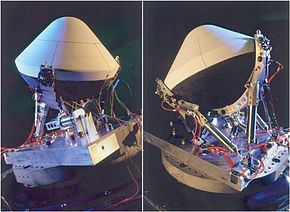Website nmp.jpl.nasa.gov/ds2/ Launch mass 2.4 kg (5.3 lb) each Launch date 3 January 1999 | Mission duration 334 Power 0.3 watts Cost 29.2 million USD (1999) Last contact 3 December 1999 | |
 | ||
Launch site Cape Canaveral AFS SLC-17 Manufacturer Lockheed Martin Space Systems Similar Zond 2, Mars 96, Northern Light, Mars Polar Lander, Mars Observer | ||
Deep Space 2 was a NASA probe part of the New Millennium Program. It included two highly advanced miniature space probes that were sent to Mars aboard the Mars Polar Lander in January 1999. The probes were named "Scott" and "Amundsen", in honor of Robert Falcon Scott and Roald Amundsen, the first explorers to reach the Earth's South Pole. Intended to be the first spacecraft to penetrate below the surface of another planet, after entering the Mars atmosphere DS2 was to detach from the Mars Polar Lander mother ship and plummet to the surface using only an aeroshell impactor, with no parachute. The mission was declared a failure on March 13, 2000, after all attempts to reestablish communications following the descent went unanswered.
Contents
Background
Each probe weighed 2.4 kg (5.3 lb) and was encased in a protective aeroshell. They rode to Mars aboard another spacecraft, the Mars Polar Lander. Upon arrival near the south polar region of Mars on December 3, 1999, the basketball-sized shells were released from the main spacecraft, plummeting through the atmosphere and hitting the planet's surface at over 179 m/s (590 ft/s). On impact, each shell was designed to shatter, and its grapefruit-sized probe was to punch through the soil and separate into two parts. The lower part, called the forebody, was designed to penetrate as far as 0.6 meters (2 ft 0 in) into the soil. The upper part of the probe, or aftbody, was designed to remain on the surface in order to radio data to the Mars Global Surveyor spacecraft in orbit around Mars. The Mars Global Surveyor would act as a relay in order to send the data collected back to Earth. The two sections of the probe were designed to remain connected via a data cable.
Mission failure
The probes reached Mars apparently without incident, but communication was never established after landing. It is not known what the cause of failure was. The crash review board suggests several possible causes for failure:
